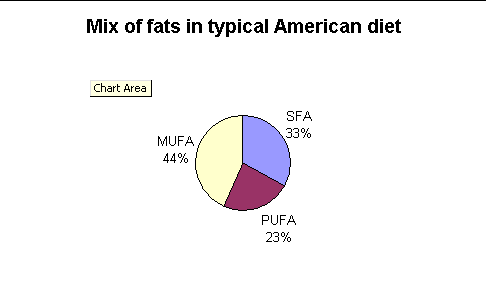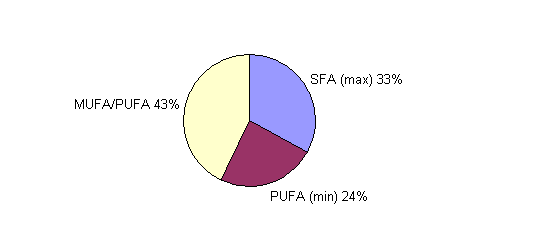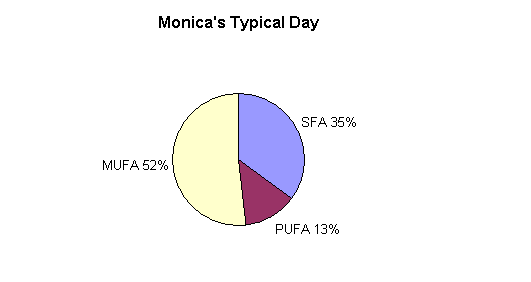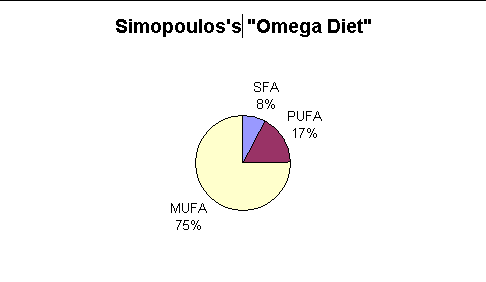Q. Is there an optimal ratio of polyunsaturated, monounsaturated, and saturated fats that you’d recommend for optimal health?
A. Interesting question, and any answer I give will be controversial, but I certainly don’t mind getting the conversation started!
Here’s how the typical American diet (which, one could argue, is clearly not optimal) breaks down, with fat taking up 34% of total calories.

Should We Eat More Monounsaturated Fats?
The traditional Mediterranean diet features a significantly higher percentage of MUFAs. Not only that, but it’s also relatively high in total fat, with about 40% of calories coming from fat. And yet, the Mediterranean diet is not only heart-healthy, it is also correlated to lower rates of obesity. In fact, some researchers argue that MUFAs might even be less “fattening” than other types of fat because of they are more likely to be burned and less likely to be stored. In her book, The Omega Diet, researcher Artemis Somopoulos, MD, proposes the following “ideal” mix of fats.
Should We Eat Less Saturated Fat?
Perhaps the biggest area of controversy is saturated fat. The 2020 Dietary Guidelines for Americans recommends limiting saturated fat to no more than 10% of calories and we’re almost there–averaging about 11% of calories from saturated fats.
However, many question whether limiting saturated fat is really necessary. After all, a 2010 meta-analysis published in the American Journal of Clinical Nutrition found that people who ate less saturated fat were just as likely to have heart disease as people who ate more.
However, as researchers from the Harvard School of Public Health pointed out, it really depends on what you replace those saturated fats with. Those who cut back on saturated fats and replaced those calories with refined carbohydrates (low-fat cookies, for example) or hydrogenated oils (margarine, for example) may have jumped from the frying pan into the fire in terms of heart-damaging ingredients. On the other hand, those who cut back on saturated fats and replaced them with PUFAs did enjoy a 20% reduction in their heart disease risk.
See also : Is Saturated Fat Back on the Hook?
How Essential Are Polyunsaturated Fats?
For the most part, the Dietary Recommendations lump MUFAs and PUFAs together as being “preferable” sources of fat. However, there are two “essential” fatty acids–meaning that the body cannot manufacture them and must get them from dietary sources. Both are PUFAs.
According to the National Academy of Sciences, adults need to consume at least 12 to 17 grams of linoleic acid (an omega-6 fat) and a minimum of 1 to 2 grams of alpha linolenic acid (an omega-3 fat) a day. For a diet that gets 30% of total calories from fat (the midpoint of the NAS’s recommended range of 25-35%), a diet that follows the Dietary Guidelines would look something like this:

I’m sure I don’t need to point out, however, that the Dietary Reference Intakes are merely intended to keep most people out of trouble. “Adequate” is usually a far cry from “optimal.”
The Omega Ratio
The only area where there is serious talk of optimal ratios, of course, is between the two major types of PUFAs: Omega-3s and Omega-6s. Although the Dietary Reference Intakes that I mentioned above imply a 10:1 ratio between Omega-6 and Omega-3, most believe that a lower ratio would be far preferable. The hard core aim for a 1:1 ratio; more moderate or pragmatic folk might settle for something like 4:1.
Given the modern food supply, maintaining a low ratio of omega-6 to omega-3 fats can be pretty challenging, especially if you don’t eat a lot of fish. Pounding fish oil is one way to do it. Limiting your intake of omega-6 (found in vegetable oils and foods made with them) is another.
See also this episode of my podcast: Fish oil and omega 3s
Is There an Answer in Here Somewhere?
As I’m sure you’ve probably realized by now, I can’t really give a one-size-fits-all answer to this question. For one thing, we don’t live on fat alone and the choices you make in the rest of your diet will have an impact here. For example, as I have observed in the past, people whose diets are very low in refined carbohydrates can often sustain a high intake of saturated fat without an increase in heart disease risk factors. Vegans, on the other hand, usually have higher carbohydrate intake but lower saturated fat intake–another equation that appears to be heart protective.
Personally, olive oil is my primary source of fat, with butter and dairy products in the #2 slot, followed closely by nuts, which I eat virtually every day. Other regular but not daily sources of fat include eggs, olives, avocados, fish, meat, flax and other seeds. I’d guess my omega ratio to be somewhere in the neighborhood of 2:1. My pie chart usually looks something like this, with fats at about 35-40% of total calories.

I’m not saying my diet would be optimal for everyone, of course, but it works well for me. And (full disclosure) when it comes to food, I’m balancing more than just nutrition. As I wrote in the introduction to my book, Secrets for a Healthy Diet:
“When it comes to diet, I am neither purist nor perfectionist. The fact is, very few of us make food choices based on nutrition alone. We are also influenced by taste, cost, availability, convenience, and habit. If you’re also trying to balance things like environmental impact, social and animal welfare, religious beliefs, and other factors, you’ll frequently have to pick your priorities….”
Fortunately, we humans appear to be fairly flexible, with the ability to thrive on a variety of dietary patterns. What’s more, we are extremely varied organisms and don’t all respond identically to the same inputs. Although it’s clearly possible to kill yourself with food (just look around you), I don’t believe there is just one “optimal” prescription for the human diet.


As a future dietitian in college, my thoughts on the issue:
I believe it’s all about moderation, which is what we should be focusing on instead of semi-complex percentages and number values. Too often someone sees the spectrum as black or white and it’s either “no butter ever” or “lay the butter on me!” The guidelines almost make it seem like you’re going to harm yourself if you eat over that 7-10% saturated fat limit in one typical day and it’s more about the pattern over a given period of time than it is any one day. If you spluge and have a few pieces of cake but you’re not doing that as part of your daily routine, there’s nothing wrong with that at all.
I also like that you bring up the point that when saturated fats are replaced with refined carbohydrates detrimental effects begin to happen. I sort of lean in the direction that saturated fat, coconut oil, butter and salt, in themselves, aren’t necessarily the culprits, but how they’re processed and put into all of the processed foods on the shelves of the grocery store that people tend to consume.
Great piece though, I really enjoyed reading it and I’m even happier to see that your conclusion was that there isn’t one set ratio or pattern, or secret formula, that is universal and that everyone is different and has different dietary needs.
Well said Daniel!!
All about moderation
I agree and disagree
As a university graduate in Nutrition, I find part of the issue is people aren’t focused enough on their daily intakes. one piece of cake is not one piece of cake for most people. It is like someone saying their going out or one drink. They never do. Maybe schedule a cake at a weekend and manage your calories to fit
When it comes to fats, too much saturated fat is always attributed to health issues. This isn’t always true and is outdated info. It is true for people with underlying issues. A simple genetic test will let you know which can make a high fat diet desirable to people inclined to eat that way.
My takeaway point is don’t be scared of fats. There are more increasing studies showing the benefits and also the issues with a higher carbohydrate diet. It will always be marketed due to how cheap rice pasta etc are to produce. Make your own mind up.
Here are some thoughts:
(1) Simopoulos’ recommendation is ridiculous and worth ignoring. Even olive oil is “too high in saturated fat” to fit into that ratio (11% saturated/FNIC data). Including nearly any nuts in the diet would make getting polyunsaturated fatty acids down unachievable. Tropical oils and nearly any animal fat would be right out because getting saturated fat would be unachievable.
(2) The idea of an “ideal ratio” is reductionist. Declaring oneself “healthy” based on ratios of types of fat would be delusional. When people focus on macronutrient ratios or similar nutrient-oriented ideals of healthy eating, they lose focus on the more important “wholesome foods” view.
(3) I feel safe in asserting, one person’s ideal will not be ideal for another. Different genetic predisposition, activity level, age, etc will strongly affect “ideal.”
(4) These fat groupings while simple are lacking practical value. As Monica stated, not all PUFAs are the same. Also, not all SFAs are the same. I think there is sufficient evidence, for example, to make MUFA oleic acid and SFA stearic acid one group as their effects are very similar. Short chain SFAs are very different than medium chain, etc. I predict eventually, these monikers will be dropped in the public health arena just as “soluble and insoluble” fiber are largely dropped.
Like you, I believe there is plenty of room for slop in macronutrient ratios. I hate to see people being slaves to nutrient numbers rather than circumspect about healthy eating patterns.
Thanks for your thoughts, Eric.
As someone who doesn’t know much about nutrition, but is trying to get healthier, understanding a general ratio for fats is helpful. For instance, I really like smoothies. I mostly use fresh or frozen fruits and vegetables. My daughter doesn’t gain weight well (DiGeorge Syndrome) so I thought adding yogurt and coconut oil would be healthy choices for us both. I asked my trainer about it and she said to just stay away from saturated fats and focus on monos and polys. I figured the yogurt and coconut oil would be fine, but the yogurt was mostly saturated and the oil was all saturated.
So I decided to look into foods that have more monos and polys. Avocado is easy to add to smoothies. We eat eggs quite a bit, and those seem to have a good ratio. I’m going to try to keep saturated fats at or below 1/3 and work from there.
So as a newbie, it’s nice to have some sort of guideline, and a source that shares different guidelines and the possible pros and cons of them.
This is a very, very interesting topic, but as you mention – very controversial. I agree that there is probably no one “optimal” ratio. I eat a lot of fat – lots of EVOO, nuts/nut butters, but also saturated fat from cheese. I don’t eat too much carbohydrate – veggies, some whole grains and fruit, and dairy products. I try my best to avoid refined carbs. I don’t believe high fat diets are necessarily the healthiest. I just find them most convenient to get adequate calories (I am one of the perpetually thin).
Also, relating to PUFAs, have you seen this new review article about LA? The debate regarding LA and inflammation is an interesting one. With diets like The Zone bashing it profusely and pinning it as a major cause of obesity, it is interesting to hear different opinions. I know Walter Willett is adamant that LA is not inflammatory.
http://www.nutritionandmetabolism.com/content/8/1/36/abstract
Thanks for the link, Terri. Another reader forwarded it to me just a couple of days ago but haven’t had a chance to read beyond the abstract yet. It’s on my list!
When you read it, see who the surveyed population is. My understanding is that in the presence of high fasting insulin, LA can be converted to AA (via DGLA and upregulated delta-5 desaturase). So omega-6 PUFA may not be the ticket for those with metabolic syndrome.
http://weightmaven.org/2011/04/21/our-western-diet-prescription-for-disaster/
My approach is to keep the PUFAs as low as possible in the diet, and in balance.
In practice, this means eating no processed seed oils, some olive oil, and eating fish regularly. I also avoid grain-fed meats, as the practice concentrates omega-6 fats in the tissues and lowers omega-3 fats.
I don’t worry about the saturated and monounsaturated fat composition of the diet, because I’ve not seen evidence that there’s much of a health risk for consumption of either, their may be some benefits, and they both seem to be clearly healthier than excess carbohydrates. (But no artificial trans fats!)
Monica’s diet keeps the omega-6 PUFAs low enough to be below the threshold that seems to create toxicity in humans and animals. That’s the same approach that I take.
Given the causal relationship between omega-6 fat intake for various types of cancer (notably breast cancer) in animals, and clear indications of a relationship between human consumption of excessive amounts of omega-6 fats, this seems like the wisest approach, since it’s still well above the likely required levels for PUFAs in the diet.
“N-3 and N-6 fatty acids in breast adipose tissue and relative risk of breast cancer in a case-control study in Tours, France”
http://onlinelibrary.wiley.com/doi/10.1002/ijc.10130/full
“Dietary polyunsaturated fatty acids and breast cancer risk in Chinese women: a prospective cohort study.”
http://www.ncbi.nlm.nih.gov/pubmed/20878979
The challenge is that by increasing the MUFA ratio you are skewing the rato of omega 6:3 to be less favorable. For example olive oil’s ratio of omega 6:3 is not ideal. So we could just have fish as our fat source – that would be the only way to obtain a 1:1 ratio of omega 3:6
How in an ideal world can you physically achieve this 1:1 ratio?
As I said above, I think that the 1:1 ratio is unrealistic and probably unnecessary. Getting the ratio from 10:1 down to 3 or 4:1 would probably deliver the lion’s share of the benefit.
thanks Monica – but…. in the mathmatical sense the difference is huge between 1:1 and 1:3 as a rato – and I would also be interested to dig a little deeper into the underlying reasons why the 1:1 ratio was established in the first place. I think the expression some things matter but they usually matter an awful lot is appropriate. I think in nutrition this is one of those things. Cancer, CVD all seem to point in this direction.
I can say from experience and observation when experimenting in my own diet – rapid improvements in skin tone and quality and also quality of thought processes when I have been a situation to leverage lots of fresh fish in the diet for example…
What strategies do you have to get as close as possible to maintain a 1:3 ratio?
I don’t think the 1:1 ratio really has been “established”–merely proposed as a (wild) guess about the likely ratio of primitive diets–and the utility or rationality of trying to emulate primitive diets is a whole ‘nother conversation!
To your expression, I would add the Pereto Principle: that 20% of an effort usually produces 80% of the result.
You might be interested to read Harris (Current Atherosclerosis Reports 2006 8:453-459). I don’t agree with all of his arguments but he makes some interesting observations on the utility of ratios vs. absolute values of n-3 and n-6.
As for real-world applications, my primary strategy is to limit omega-6 and not worry too much. See also: http://nutritiondiva.quickanddirtytips.com/fish-oil-and-omega-3-fats.aspx
hmm.. it may not be an established level or realistic level to strive for in our present society, but there may be an evolutionary background to this. I take it that the readers of this blog are familiar with the work of Stephen Cunnane ( U of T, Laval).
There could quite well be a lot of fish in our ancestral background. The development of our large brain could in fact be due to large intakes of N-3. And of course there is a serious problem with the the N-6 in that it uses the same pathway as N-3 and does so preferentially. Lots of research that did not take into account the presence of N-6 often went off the rails by not being able to show clear benefit.
And lastly but certainly not in the least: our mitochondria do have a serious problem with an overload of N-6 and causes a lot of ALEs . Recent research is beginning to suspect that all problems related to our CNS (Alzheimer’s, Parkinson’s, ALS, and now the ever increasing appearance of peripheral neuropathy) have their origin in ‘worn out’ mito’s. They can’t do their work properly and when they can’t do their work properly the biggest energy users are the first to suffer : your brain and your signaling system(CNS)
Check out the following website that teaches about the
importance of Omega-3 fatty acids in 7 easy lessons. http://www.fatfaq.org
There are 2 fatty acid balancing acts that our body seems to respond to:
1. a Balance of Total Fats
2. a Balance of Omega-6: Omega-3 fatty acids
Note: click one slide at a time to view at your own pace.
Enjoy!
Vegetable oils lack Vitamins and Minerals.
linoleic acid + Vitamin B6 = DGLA (anti-inflammatory)
linoleic acid – Vitamin B6 = AA (really inflammatory in excess)
search google: vitamin b6 dgla
Nuts contain a good amount of Vitamin B6. I wouldn’t know about seeds.
Thanks, Monica. I am following a relatively low carb plan, and keeping track of it all on MyFitnessPal. I needed a general idea of the percentages of fats, and you did the trick.
Is there a website (or websites) you’d recommend for tracking types of fatty acids in the diet? Most of the tracking websites I find will give nothing more than the gross macronutrient content.
The best site for this level of detailed tracking used to be nutritiondata.com. Unfortunately, the site is not being maintained or updated by its new owner. As a result, they are about 5 years behind on USDA updates and have several unresolved bugs (and no mobile optimized interface).
That said, they might still be the best way to get this information. If you track for several days, you should get a fairly good idea how your diet breaks down. (There’s no need to monitor this on an ongoing basis at the gram level. )
Cronometer its better than nutrition data.
Thanks! I haven’t tried it yet, but it’s the second site I’ve ever come across that meets one of my major criteria. I simply MUST be able to track my foods in grams/ounces rather than just in cups.
Even if I’m actually USING a measuring cup, the amount I judge to be a cup can vary by as much as 100%, depending on how you pack it. Does that really make a difference, whether I’m getting one ounce of kale or two? Probably not. But the uncertainty makes it psychologically unsatisfying to try to track it. I never seem to be able to keep it up three days in a row. Now I have a second site that gives bunches of data and also lets me input in weight instead of volume.
Thanks!
Thank you. Yes. It used to be a great site.
Unfortunately, that site locks up at about the third or fourth item added to a recipe. After that, it sometimes just freezes, sometimes fails to add the next foods in, sometimes adds them in, but doesn’t show them on the list. The only solution I’ve found is to leave the site entirely and then to STAY off of it for an hour. That resets it and allows another two or three or four items to be added. Since I tend to eat two or three dozen different foods a day (I cook for myself!) this is too cumbersome to be useful.
Do you know of any other sites that might work?
I haven’t yet played around with it but it looks like this might work:
http://supertracker.usda.gov
How about an Omega 9 which is a natural regulator of Appetite, Body Fat (Cholesterol) and weight. This Omega 9( has over 250 preclinical and clinical articles published) is endogenous to the human body and overeating saturated fatty foods and sugary foods is responsible for disrupting the natural feedback mechanism of satiety where this Omega 9 plays a natural role.
This Omega 9 has been shown to reduce weight and reduce cholesterol in clinical studies. Research yourself for OleoylEthanolamide (OEA) now available for human consumption from Nutriforward as RiduZone. There are patents on it from UC Irvine that we have exclusively licensed. We are seeing good results in humans as well.If interested to learn more contact Andy.Desai@Riduzone.com.
I eat foods with omega-3 fatty acids daily but because I don’t eat processed food and don’t use safflower, sunflower, corn or canola oil, I think am getting virtually no omega-6 fatty acids. Is there a problem with getting too little omega-6 fatty acids and throwing the ratio off in the other direction? I know omega-6 is an essential fatty acid and is needed to synthesize arachadonic acid.
If you eat any nuts, seeds, or whole grains, you’re probably getting enough omega-6!
Hi –
Achieving a relatively consistent ratio of omega 6 to omega 3 oils was driving me nutty; consequently, I opted to supplement with krill oil capsules.
That begs the questions, is that a good idea, and if so, what would be a suggested amount to take?
Kindly note, of the various nutrition blogs, yours is my golden standard.
Best regards,
Nick M.